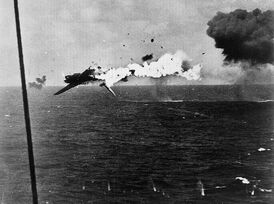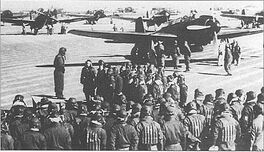The Nakajima B6N Tenzan (Allied codename Jill) was a torpedo bomber that was used by Japan during World War II.
Description[]
The first production model of the B6N1 with only around 133 examples produced. The B6N1 had a Nakajima NK7A Mamoru engine that was capable of propelling it at speeds of up 480 kilometers per hour.[1] The armament of the B6N consisted of a single 7.7mm machine gun firing from the gunner position and a secondary 7.7mm machine gun firing through a ventral position. Early examples though had a 7.7mm machine gun mounted in a forward firing mount in the port wing of the aircraft. However, the B6N had a crew of three crew members, with the third crew member being a navigator/bombardier.
The total length of the B6N was around 10.8 meters with a total weight of around 3,010 kilograms.[2] The aircraft also had a maximum range of around 1,700 kilometers with a service ceiling of about 9,000 meters. The reliability of the B6N in the field was excellent with the aircraft's engine power being much improved from its predecessor, the B5N.
Variants[]
The B6N had several minor improvements introduced as the series' production progressed, with the main variant of the series being the B6N2 model. The B6N2 model's main introduction came from the use of the Mitsubishi MK4T Kasei 25 engine which was simple to produce and repair but had a worsened performance from its Nakajima predecessor. The only produced sub variant of the B6N2 was the B6N2a, also known as the B6N2 ko. This example had the rear facing armament revised, with a 13mm machine gun replacing the previous 7.7mm one in the gunner position The B6N3 meanwhile was prototype that was intended to be fully designed to operate from land bases to compensate for the fact that by that time, all the Japanese aircraft carriers had been sunk in combat.
History[]

A Nakajima B6N exploding after being hit by a 5" gun off of Kwajalein atoll in late 1943
Development[]
The Nakajima B6N was initially developed from the time period of 1939 to 1942 following the Japanese military's request for a new torpedo bomber to replace its quickly aging Nakajima B5N which had been found to be highly inadequate for the time. Naturally, the Nakajima Aircraft Company based the successor on the original B5N. The B6N sported modified wings and a greatly improved engine. However, towards the end of the B6N's development, Nakajima had disagreed with the IJN's request to use the Mitsubishi Kasei engine, naturally preferring to utilize the Nakajima NK7A Mamoru engine of their own design.[3] However, the engine's complications hurted the economic side of its production and thus outweighed the benefits of its reliability and long range.
Therefore, the B6N was severely limited, with full-scale production of the B6N only being introduced by 1943. In the end, Nakajima grudgingly agreed to replace its own engine with that of the Mitsubishi to allow full production.
Combat Service[]
Following the B6N1's introduction in mid-1943, examples were immediately issued to aircraft carrier groups such as those operating on the last Japanese carriers such as the Zuikaku. By late 1943, the B6N2 was in full service with naval and land based units around the south pacific, although it still did not immediately fulfill its goal of replacing all older B5Ns still in service.

Several B6Ns parked with their pilots
Still, the B6N became a standard Japanese bomber, operating in the South Pacific for a majority of the campaign.
By 1944, B6Ns operating from Japanese carriers engaged in the Battle of Philippine Sea, though with the allied air power soaring, little damage was sustained to enemy ships. Results were average, with B6Ns not being able to inflict serious damage to the allies. However, in late 1944/1945 like most other Japanese naval based aircraft, the B6N was launched from land based air fields to be used as a Kamikaze weapon against Allied carriers.[4] In total, around 1,200 aircraft examples had been produced during the war.
References[]
- ↑ http://www.wwiivehicles.com/japan/aircraft/torpedo-bomber/nakajima-b6n-tenzan-jill.asp
- ↑ http://www.militaryfactory.com/aircraft/detail.asp?aircraft_id=480
- ↑ http://www.historyofwar.org/articles/weapons_nakajima_B6N.html
- ↑ http://www.century-of-flight.net/Aviation%20history/photo_albums/timeline/ww2/Nakajima%20jill.htm
| |||||||||||||||||
